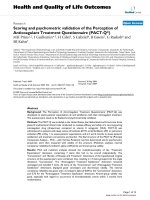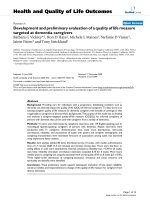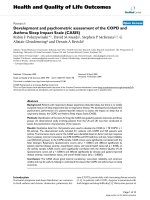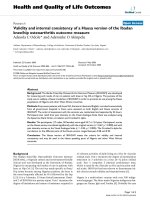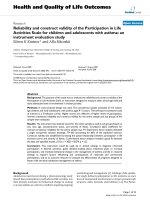Báo cáo hóa học: " Electronic and magnetic properties of SnO2/CrO2 thin superlattices" doc
Bạn đang xem bản rút gọn của tài liệu. Xem và tải ngay bản đầy đủ của tài liệu tại đây (429.38 KB, 5 trang )
NANO REVIEW Open Access
Electronic and magnetic properties of SnO
2
/CrO
2
thin superlattices
Pablo D Borges
1*
, Luísa MR Scolfaro
2
, Horácio W Leite Alves
3
, Eronides F da Silva Jr
4
, Lucy VC Assali
1
Abstract
In this article, using first-principles electronic structure calculations within the spin density functional theory,
alternated magnetic and non-magnetic layers of rutile-CrO
2
and rutile-SnO
2
respectively, in a (CrO
2
)
n
(SnO
2
)
n
superlattice (SL) configuration, with n being the number of monolayers which are considered equal to 1, 2, , 10
are studied. A half-metallic behavior is observed for the (CrO
2
)
n
(SnO
2
)
n
SLs for all values of n. The ground state is
found to be FM with a magnetic moment of 2 μ
B
per chromium atom, and this result does not depend on the
number of monolayers n. As the FM rutile-CrO
2
is unstable at ambient temperature, and known to be stabilized
when on top of SnO
2
, the authors suggest that (CrO
2
)
n
(SnO
2
)
n
SLs may be applied to spintronic technologies since
they provide efficient spin-polarized carriers.
Introduction
A variety of heterostructures h ave been studied fo r spin-
tronics applications, and they have proved to have a great
potential for high-performance spin-based electronics
[1]. A key r equirement in developing most devices based
on spins is that the host material must be ferromagnetic
(FM) above 300 K. In addition, it is necessary to have effi-
cient spin-polarized carriers. One approach to achieve
the spin injection is to create built-up superlattices (SLs)
of alternating magnetic and non-magnetic materials. One
attempt has already been made by Zaoui et al. [2],
through ab initio electronic structure calculations for the
one monolayer (ZnO)
1
(CuO)
1
SL, with the aim of obtain-
ing a half-meta llic behavior material, since they are 100%
spin polarized at the Fermi level and therefore appear
ideal for a well-defined carrier spin injection.
In this study, the magnetic a nd electronic properties
of (CrO
2
)
n
(SnO
2
)
n
SLs with n = 1, 2, , 10 being the
number of monola yers are investigated. These systems
are good candidates to obtain a half-metallic behavior
material since bulk rutile-CrO
2
has shown experimen-
tally this behavior [3] and recently magnetic tunnel
junctions based on CrO
2
/SnO
2
epitaxial layers have
been obtained [4].
Theoretical method
All the calculations were based on the spin density func-
tional theory. The Projector-Augmented Wave method
implemented in the Vienna Ab-initio Simulation Package
(VASP-PAW) [5,6] was employed in this study, and for
the exchange-correlation potential, the generalized gradi-
ent approximation and the Perdew, Burke, and Ernzerhof
(GGA-PBE) approach was used [7]. The valence electro -
nic distribution for the PAWs representing the atoms
were Sn– 4d
10
5s
2
5p
2
,Cr– 3d
5
5s
1
, and O-2s
2
2p
4
. Scalar
relativistic effects were included. For simulation of the
one monolayer (CrO
2
)
1
(SnO
2
)
1
SL, a supercell with 12
atoms (2Sn, 2Cr, and 8O) in the rutile structure as shown
in Figure 1a was used. For this case, a 4 × 4 × 3 mesh of
Monkhorst -Pack k-points was used for integration in the
SL BZ. All the calculations were done with a 490 eV
energy cutoff in the plane-wave expansions.
Results and discussion
For the (CrO
2
)
1
(SnO
2
)
1
SL, the calcula tion was started
with the experimental lattice parameters of the tin diox-
ide, a =4.737Å,c/a = 0.673, and u = 0.307 [8-10]. The
system was relaxed until the residual forces on the ions
were less than 10 meV /Å. Good agreement between the
calculated and the available experimental values for the
lattice parameters is obtained, as seen in Table 1. Figure
1b shows that the ground state is ferromagnetic (FM),
being the most stable state compared with the non-mag-
netic (NM) and anti-ferromagnetic (AFM) ones. For the
* Correspondence:
1
Instituto de Física, Universidade de São Paulo, CP 66318, São Paulo, SP,
05315-970, Brazil.
Full list of author information is available at the end of the article
Borges et al. Nanoscale Research Letters 2011, 6:146
/>© 2011 Borges et al; licensee Springer. This i s an Ope n Access article distributed under the terms of th e Creative Commons Attribution
License ( which permits unrestricted use, distribution, and reproduction in any medium,
provided the original work is properly cited.
ground state, the total magnetic moment gives a value of 2
μ
B
per chromium atom. Figure 2a,b presents the total den-
sity of states (TDOS) and the projected density of states
(PDOS), respectively for the Cr 3d orbital, showing that the
system has a half metallic behavior, with the Cr 3d orbital
appearing in the gap region, characterizing a metallic-like
behavior for the majo rity sp in and a semiconductor-like
behavior for the minority spin. The band structures of the
SL for spin up and spin down are depicted in Figure 2c. A
band gap of approximately 1.71 eV is obtain ed for the m in-
ority spin at the Г-point. T here is a smaller gap for spin f lip
excitations from the Fermi level, which is approximately
0.86 eV. For the (SnO
2
)
n
(CrO
2
)
n
SLs with n >1, considered
here up to n = 10, it was observed that t he ground s tate
remains as FM. The interplay of the SnO
2
and CrO
2
layer
thicknesses does not change the half-metallic behavior, as
can be verified through the DOS shown in Figure 3a,b for
n = 10. The magnetic moment per Cr atom, in all the stu-
died cases, is the same and equal to 2 μ
B
. Moreover, the SL
magnetization does not depend on the number of mono -
layers. This has been verified by performing calculations
with one monolayer of CrO
2
grown bet ween 3, 7, and 11
monolayers of SnO
2
. It was observed that the SL magneti-
zation remained equal to 2 μ
B
. Our results show a 100%
spin polarization at the Fermi level, ideal for a well-defined
carrier spin injection.
An investigation, related to strain effects along the z-
direction for the rutile phase of CrO
2
, was made by simu-
lating bulk rutile-CrO
2
,ontopoftindioxide,assuming
for CrO
2
the lattice parameter a of SnO
2
,i.e.,asituation
in which the chromium dioxide is tensile. By varying the
ratio c/a
SnO2
and minimizing the total energy of the sys-
tem, the authors obtained the curves shown in Figure 4a
for the FM, AFM, and NM states, showing that the tra n-
sition from a FM to an AFM state occurs when c/a
SnO2
is
about 0.544 . At this value , a magnetic moment reduction
is observed, as depicted in Figure 4b. These results sug-
gest a magn etization change when the SL is under str ain
or, in other words, when CrO
2
is compressed. A similar
behavior was found by Srivastava et al. for bulk rutile-
CrO
2
under pressure [11].
The advantage in using the SnO
2
/CrO
2
SLs, despite
the fact that CrO
2
is unstable at room temperature, is
that its stability becomes possible when grown on SnO
2
[12]. Our results showed that the interface effects due to
the lattice mismatch do not change the chromium diox-
ide magnetism characteristics. If the distances between
two planes perpendicular to the rutile c-axis containing
the Cr
2
and Sn
1
arecompared(seeFigure1a),atthe
interface region of the SL, before and after full
Figure 1 The supercell model and total energies for the systems. (a) Supercell used to study the (SnO
2
)
1
(CrO
2
)
1
SL, and (b) Total energies
for the non-magnetic (NM) and anti-ferromagnetic (AFM) states relative to the ferromagnetic (FM) state. The dashed lines connecting the points
are to guide the eyes.
Table 1 Experimental and calculated values for the lattice
parameters of the SnO
2
, CrO
2
, and of the (CrO
2
)
1
(SnO
2
)
1
and (CrO
2
)
10
(SnO
2
)
10
SLs in the rutile structure
a (Å) c/a u
SnO
2
4.737
a
0.673
a
0.307
a
4.839
b
0.670
b
0.306
b
CrO
2
4.421
c
0.6596
c
0.301
c
4.455
d
0.6569
d
0.304
d
(CrO
2
)
1
(SnO
2
)
1
4.625
d
0.658
d-
(CrO
2
)
10
(SnO
2
)
10
4.640
d
6.546
d-
a
[8];
b
[9];
c
[10];
d
this work.
Borges et al. Nanoscale Research Letters 2011, 6:146
/>Page 2 of 5
-6 -5 -4 -3 -2 -1 0 1 2 3 4 5
-14
-7
0
7
1
4
-6 -5 -4 -3 -2 -1 0 1 2 3 4 5
-6
-3
0
3
6
Energy (eV)
-6
-5
-4
-3
-2
-1
0
1
2
3
4
5
*
Energy (eV)
X
up
down
*
M
Z
*
XM
*
Z
E
F
TD
O
S
E
F
majority spin
minority spin
(c)
(b
)
PDOS
Energy (eV)
(a)
majority spin
minority spin
Figure 2 Density of states a nd band structure for the (SnO
2
)
1
(CrO
2
)
1
SL. (a) Total densi ty of states (TDOS), (b) Project density of states
(PDOS) for the Cr-d orbital, (c) Band structure, for spin up and spin down, along the main symmetry lines of the SL BZ. The Fermi level, E
F
, is set
to zero in (a), (b), and (c).
-9-6-30369
-40
-30
-20
-10
0
10
20
30
4
0
0
1
2
3
4
Density o
f
S
tates
Ener
gy
(
eV
)
E
F
majority spin
minority spin
Cr3d
(a)
(b)
Total energy (eV)
NM FM AFM
Figure 3 Density of states and total energies for the SL with n=10. (a) Total density of states (in black) and project density of states (in
gray) for the Cr–3d. (b) Total energies for the non magnetic (NM) and anti-ferromagnetic (AFM) states relative to the ferromagnetic (FM) state.
The Fermi level, E
F
, is set to zero. The dashed lines connecting the points are to guide the eyes.
Borges et al. Nanoscale Research Letters 2011, 6:146
/>Page 3 of 5
relaxations, then changes of only approximately 4% are
observed for all the studied SLs.
Conclusions
In conclusion, the results of first-principles electronic
structure calculati ons, within t he spin density functional
theory, carried out for (CrO
2
)
n
(SnO
2
)
n
SLs formed by
alternating magnetic and non-magnetic layers of rutile-
CrO
2
and rutile-SnO
2
, where the number of monolayers n
was varied from 1 to 10, have been reported in this article.
A half-metallic behavior is observed for all the studied
(CrO
2
)
n
(SnO
2
)
n
SLs. The ground state is FM, with a mag-
netic moment of 2 μ
B
per chromium atom, which is inde-
pendent of the number of monolayers. As the FM rutile-
CrO
2
is unstable at ambient temperature, and known to
be stabilized when on top of SnO
2
,itissuggestedthat
(CrO
2
)
n
(SnO
2
)
n
SLs may be applied to spintronic technol-
ogies since they provide efficient spin-polarized carriers.
Abbreviations
AFM: anti-ferromagnetic; FM: ferromagnetic; GGA-PBE: generalized gradient
approximation and the Perdew, Burke, and Ernzerhof; NM: non-magnetic;
PDOS: projected density of states; SL: superlattice; TDOS: total density of
states; VASP-PAW: Vienna Ab-initio Simulation Package and the Projected
Augmented Wave.
Acknowledgements
The authors would like to thank the partial support from the Brazilian
funding agencies FAPEMIG, FAPESP, CAPES, and CNPq, and from the
Material, Science, Engineering and Commercialization Program at the Texas
State University in San Marcos.
Author details
1
Instituto de Física, Universidade de São Paulo, CP 66318, São Paulo, SP,
05315-970, Brazil.
2
Department of Physics, Texas State University, San Marcos,
TX, 78666, USA.
3
Universidade Federal de São João Del Rei, CP 110, São Joao
Del Rei, MG, 36301-160, Brazil.
4
Departamento de Fisica, Universidade Federal
de Pernambuco, Recife, PE, 50670-901, Brazil.
Authors’ contributions
PB performed the ab initio calculations, participated in the analysis, and
drafted the manuscript. LS and PB conceived of the study. HA, ES, LA, and
LS participated in the analysis and in the production of a final version of the
manuscript. All authors read and approved the final manuscript.
Competing interests
The authors declare that they have no competing interests.
Received: 25 August 2010 Accepted: 15 February 2011
Published: 15 February 2011
References
1. Wolf SA, Awschalom DD, Buhrman RA, Daughton JM, von Molnár S,
Roukes ML, Chtchelkanova AY, Treger DM: Spintronics: A Spin-Based
Electronics Vision for the Future. Science 2001, 294:1488.
2. Zaoui A, Ferhat M, Ahuja R: Magnetic properties of (ZnO)1/(CuO)1 (001)
superlattice. Appl Phys Lett 2009, 94:102102.
3. Anguelouch A, Gupta A, Xiao Gang, Abraham DW, Ji Y, Ingvarsson S,
Chien CL: Near-complete spin polarization in atomically-smooth
chromium-dioxide epitaxial films prepared using a CVD liquid precursor.
Phys Rev B 2001, 64:180408R.
4. Miao GX, LeClair P, Gupta A, Xiao G, Varela M, Pennycook S: Magnetic
tunnel junctions based on CrO2/SnO2 epitaxial bilayers. Appl Phys Lett
2006, 89:022511.
-49.5
-49.0
-48.5
-48.0
-47.5
-47.
0
1.0
1.5
2.0
2.5
3.0
3.5
4.0
AFM
FM
NM
Total energy
(
eV
)
a
SnO2
= 4.834 A
(a)
0.50 0.52 0.54 0.56 0.58 0.60 0.62 0.64 0.66 0.68 0.7
0
(b)
Mag. moment per cell (P
B
)
c/a
S
n
O
2
c/a
SnO2
= 0.544
0.50 0.52 0.54 0.56 0.58 0.60 0.62 0.64 0.66 0.68 0.70
Figure 4 Study of strain effects on the magnetic behavior. (a) Total energy versus the c/a
SnO2
parameter for bulk rutile-CrO
2
for AFM, FM,
and NM states. (b) Magnetic moment per cell versus the c/a
SnO2
parameter.
Borges et al. Nanoscale Research Letters 2011, 6:146
/>Page 4 of 5
5. Kresse G, Furthmuller J: Efficiency of ab-initio total energy calculations for
metals and semiconductors using a plane-wave basis set. Comput Mater
Sci 1996, 6:15.
6. Kresse G, Furthmuller J: Efficient iterative schemes for ab initio total-
energy calculations using a plane-wave basis set. Phys Rev B 1996,
54:11169.
7. Perdew JP, Burke K, Ernzerhof M: Generalized Gradient Approximation
Made Simple. Phys Rev Lett 1996, 77:3865.
8. Wycokoff R: In Crystal Structures. Volume 1. 2 edition. New York, London:
John Wiley & Sons; 1963.
9. Borges PD, Scolfaro LMR, Leite Alves HW, da Silva EF Jr: DFT study of the
electronic, vibrational, and optical properties of SnO2. Theor Chem Acc
2010, 126:39.
10. Maddox BR, Yoo CS, Kasinathan D, Pickett WE, Scalettar RT: High-pressure
structure of half-metallic CrO2. Phys Rev B 2006, 73:144111.
11. Srivastava V, Sanyal SP, Rajagopalan M: First Principles study of pressure
induced magnetic transition in CrO2. Indian J Pure Appl Phys 2008, 46 :397.
12. Zabel H, Bader SD, (Eds): Magnetic Heterostructures: Advances and
Perspectives in Spinstructures and Spintransport STMP 227 Berlin: Springer;
2008.
doi:10.1186/1556-276X-6-146
Cite this article as: Borges et al.: Electronic and magnetic properties of
SnO
2
/CrO
2
thin superlattices. Nanoscale Research Letters 2011 6:146.
Submit your manuscript to a
journal and benefi t from:
7 Convenient online submission
7 Rigorous peer review
7 Immediate publication on acceptance
7 Open access: articles freely available online
7 High visibility within the fi eld
7 Retaining the copyright to your article
Submit your next manuscript at 7 springeropen.com
Borges et al. Nanoscale Research Letters 2011, 6:146
/>Page 5 of 5

